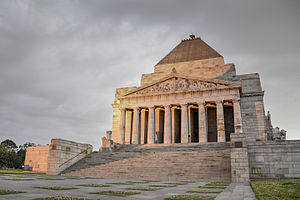
Back Shrine of Remembrance German Μνημείο Ηρώων της Αυστραλίας Greek Shrine of Remembrance Spanish Shrine of Remembrance French Shrine of Remembrance Italian 戦没者慰霊館 (メルボルン) Japanese 전쟁기념관 (멜버른) Korean Santuário da Lembrança Portuguese Монумент памяти (Мельбурн) Russian Spomenik vojnim žrtvam v Melbournu Slovenian
| Shrine of Remembrance | |
|---|---|
| Shrine of Remembrance Trustees | |
 Shrine of Remembrance | |
| For the Australian soldiers of all wars post World War I | |
| Established | 1918 |
| Unveiled | November 11, 1934 |
| Location | 37°49′50.0″S 144°58′24.4″E / 37.830556°S 144.973444°E |
| Designed by | Phillip Hudson and James Wardrop |
| Website | www.shrine.org.au |
| Official name | Shrine of Remembrance |
| Type | State Registered Place |
| Criteria | a, c, d, e, g |
| Designated | December 14, 1991 |
| Reference no. | H0848[1] |
| Heritage Overlay number | HO489[1] |
The Shrine of Remembrance (commonly referred to as The Shrine) is a war memorial in Melbourne, Victoria, Australia, located in Kings Domain on St Kilda Road. It was built to honour the men and women of Victoria who served in World War I, but now functions as a memorial to all Australians who have served in any war. It is a site of annual observances for Anzac Day (25 April) and Remembrance Day (11 November), and is one of the largest war memorials in Australia.
Designed by architects Phillip Hudson and James Wardrop, both World War I veterans, the Shrine is in classical style, based on the Tomb of Mausolus at Halicarnassus and the Parthenon in Athens, Greece.[2] The crowning element at the top of the ziggurat roof references the Choragic Monument of Lysicrates. Built from Tynong granite,[3] the Shrine originally consisted only of the central sanctuary surrounded by the ambulatory. The sanctuary contains the marble Stone of Remembrance, upon which is engraved the words "Greater love hath no man" (John 15:13); once per year, on 11 November at 11 a.m. (Remembrance Day), a ray of sunlight shines through an aperture in the roof to light up the word "Love" in the inscription.[4][5] Beneath the sanctuary lies the crypt, which contains a bronze statue of a soldier father and son, and panels listing every unit of the Australian Imperial Force.
The Shrine went through a prolonged process of development, which began in 1918 with an initial proposal to build a Victorian memorial. Two committees were formed, the second of which ran a competition for the memorial's design. The winner was announced in 1922.[6] However, opposition to the proposal, led by Keith Murdoch and the Herald Sun, forced the governments of the day to rethink the design. A number of alternatives were proposed, the most significant of which was the Anzac Square and cenotaph proposal of 1926. In response, General Sir John Monash used the 1927 Anzac Day march to garner support for the Shrine, and finally won the support of the Victorian government later that year. The foundation stone was laid on 11 November 1927, and the Shrine was officially dedicated on 11 November 1934.[7]
- ^ a b "Shrine of Remembrance". Victorian Heritage Database. Government of Victoria. Retrieved 22 November 2023.
- ^ Cite error: The named reference
TaylorP101was invoked but never defined (see the help page). - ^ Cite error: The named reference
Royallwas invoked but never defined (see the help page). - ^ Heilbron, J. L. (1999). The Sun in the Church: Cathedrals as Solar Observatories. Cambridge, Massachusetts and London, England: Harvard University Press. pp. 288–289. ISBN 0-674-00536-8.
- ^ Cite error: The named reference
EducationProgramP8-10was invoked but never defined (see the help page). - ^ Cite error: The named reference
InglisP301-302was invoked but never defined (see the help page). - ^ Taylor (2005), pp. 101–102
© MMXXIII Rich X Search. We shall prevail. All rights reserved. Rich X Search